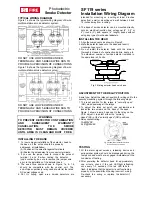
Mercedes-Benz Body & Equipment Guideline for Metris - BM 447, Version November 27, 2015.
!
Please observe the revision notes compared to 09/18/2015 ! Only print out complete sections of the current version!
20
2.4 Product safety and product liability
2 General and regulatory
2.4
Product safety and product liability
2.4.1 Product safety
Both vehicle manufacturers and upfitters must always
ensure that the products they are responsible for
manufacturing are safe when they are brought into
circulation and do not present a hazard to the user or
to third parties. Otherwise, there may be consequences
under civil, criminal or public law. Every manufacturer is
always liable for the product that it has manufactured.
The manufacturer of attachments, bodies, equipment
or conversions must guarantee compliance with
national product safety legislation
.
2.4.2 Product liability
The upfitter bears responsibility for the following fac-
tors:
•
The operational and road safety of the body
•
The operational and road safety of parts and modi-
fied equipment
•
Testing and maintaining the operating and driving
safety of the vehicle after the body/equipment is
mounted (the body and/or equipment must not
have a negative effect on the driving, braking or
steering characteristics of the vehicle)
•
Influences of parts or modifications on the chassis
•
Consequential damage resulting from the attach-
ment, equipment or modification
•
Consequential damage resulting from retrofitted
electrical and electronic systems
•
Maintenance of functional reliability and unob-
structed movement of all moving parts of the chas-
sis (e.g. axles, springs, propeller shafts, steering,
gearshift linkages etc.) after mounting the body;
also in cases of diagonal torsion on the vehicle
2.4.3 Safety-relevant features
Components and systems are safety-relevant when
their fault or failure could result in an immediate danger
to the life and limb of road users.
Daimler AG recommends that an assessment of the
safety relevance of the components or functions be
carried out for the following work:
•
Modifications on the chassis
•
Installations in the vehicle
•
Interface between vehicle and body (mechanical
components, electrical/electronic components,
power take-offs, hydraulic components, pneumat-
ics)
A component or function is to be classified as safe-
ty-relevant when at least one of the following ten safety
aspects could reasonably be expected to occur:
•
Momentary loss of sight of the road
•
Loss of ability to steer
•
Loss or partial failure of the braking functions
•
Failure of driving functions
•
Uncontrolled propulsion
•
Sudden failure of driving power
•
Escape of fuel/risk of fire
•
Loosening of cargo/trailer/parts
•
Injury from operation and other functions of the
vehicle
•
Occupant protection in accidents
















































